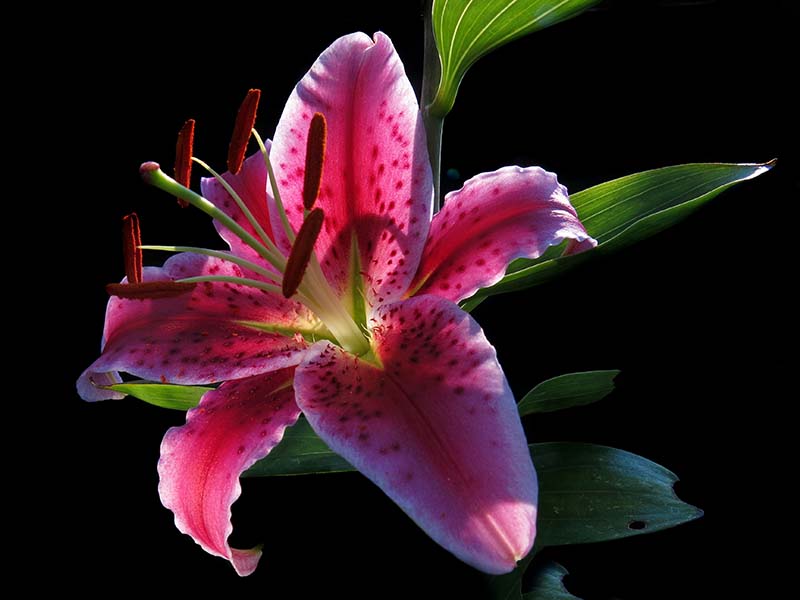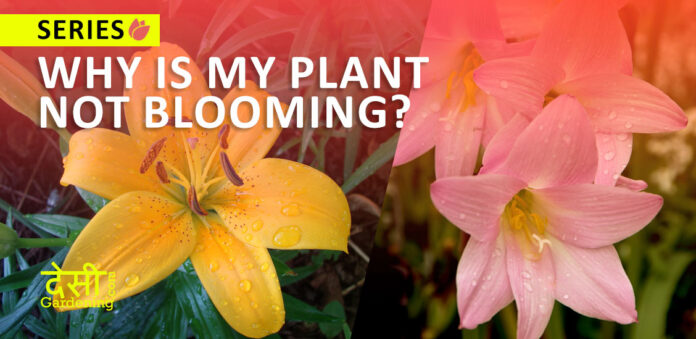Namaskar Desi Gardeners. Have you ever had a lily not blooming although it has grown well with a lot of leaves? This is a common complaint of many gardeners and unfortunately, there are not many helpful resources for solving the issue.
Lilies grow from bulbs and there are hundreds of varieties of it. Here we will take four most popular lilies grown – Amaryllis, Oriental, Asiatic and Rain Lilies – and see the probable causes for the plant to not have flowers.
Reasons for Amaryllis lily not blooming
Amaryllis
In India as well as over the world, the Amaryllis lily is the most popularly grown. It has beautiful showy flowers and comes in various shades. Every year new varieties are introduced in the flower bulb market. Amaryllis is an easy to grow plant that can survive without much care. To get good flowering, we need to keep in mind a few points. Also if your lily is not blooming, there could be some specific things you may have to do. Note that Amaryllis flowers only once in its blooming season.
Overwatering : Amaryllis bulbs will rot if the soil gets overwatering. If there is no proper drainage and the water stands, the bulb will start to go soft and bad. In this stage, the plant will lose its leaves and of course, will not flower at all.
Small or immature bulbs: The mature Amaryllis bulbs give birth to small bulbs. These bulblets need to grow and mature. Unless these are mature they will not flower and will only have foliage.
When buying Amaryllis bulbs, choose the ones that are big. The way to check if the bulb is mature is to see if it has bulblets. While planting, remove these bulblets and put in soil and next year, you will have more plants.
Too much nitrogen in soil: Amaryllis bulbs often tend to get big beautiful leaves but no flowers. One of the reasons for this is giving it nitrogen based fertilizer like urea. Bulbs do not need much nitrogen. Instead give them a balanced NPK fertilizer. They also benefit from bonemeal (or rock phosphate instead of it).
The ideal potting soil for Amaryllis is to have 30 – 40 % vermicompost mixed with well draining soil and some sand. To the soil add neem powder and bonemeal. After the plant sprouts you can feed it with potash or banana peel fertilizer to induce flowering.
Planting the wrong way: While planting the Amaryllis bulb, make sure to keep one-third of the bulb above the soil. Never put the crown inside the soil. Amaryllis does not need too much of a big container to grow. The bulb should just get just enough space to grow and gather nutrients.
Insect attack: Sometimes small insects and caterpillars eat away the bulbs layer by layer. In the rainy season it is a common issue. This will stress the bulb and it will not flower for a long time.
View this post on Instagram
Vernalization: This is the most important and common reason why your Amaryllis lily is not blooming. Vernalization, in simple terms, is to let the bulbs ‘get some sleep’.
Amaryllis goes through different stages. First it sprouts. When put in the soil, the leaves and flowers start to come up. After the flowering is over, we need to do two things. We should let the bulbs out in the garden where they will get sunlight, water and fertilizer regularly. This way the plant prepares food and stores in its bulb for the next year. After a few months, the leaves will start to dry. At that time reduce the watering and then stop it till the leaves dry. Take the bulbs out, clean the bulb, cut off the roots and leaves and let the bulb dry out for two days in the open. Then comes the most important part – store the bulbs in a cool, dark place for at least 2 to 3 months. This is when the plant takes rest and prepares the buds inside it.
You can apply some fungicide powder on the bulbs to keep it safe. Check the bulbs regularly. After the ‘sleep’ is over, take it out and plant it in your garden again.
Asiatic Lily and Oriental Lily
Asiatic and Oriental Lilies are similar in many aspects. Therefore, their needs and issues are similar. It is very easy to grow Asiatics and Orientals but in spite of that if your lily is not blooming, you need to check a few things. Note that these lilies will bloom only once a year.
View this post on Instagram
Bulb size: If the bulb of your Asiatic and Oriental lily is small, it is called a pup or bulblet and it will not flower. It is still a ‘child’ and so it will grow a lot of leaves and gather food and energy for the next season. However, these plants have beautiful leaves and will beautify your garden. The best thing is, lilies multiply fast so in a few years you will have too many new bulbs in your garden for free.
Poor soil : The Asiatic and Oriental lily, once they start sprouting need a lot of food from the soil. Do not delay planting your bulbs if they are starting to sprout. The earlier you do, the bigger flowers you will get.
I add 50% vermicompost in the potting mix. To make the soil well draining, add sand. Never let the water stand or it will rot your bulbs. Add a fistful of bonemeal below the bulb when you plant it. In the soil add neem cake powder to prevent fungal and pest attacks and also add a little mustard cake that will act as a slow release fertilizer.
Asiatic and Oriental lily grow very fast and can reach heights up to two to three feet. Oriental lilies are taller plants than Asiatics and can grow up to four feet or more. Although the Asiatic does not have any but the Oriental lily is very fragrant. Both the Asiatic and Oriental lily have beautiful big flowers.
Fungal attack: Although both of these plants are fairly resistant to pest attacks, they can be attacked b fungal problems. I have lost Asiatic lily buds due to this. The small buds start going brown and then fall off. Application of fungicide is the only way to prevent it.

Formation of seed pods: If you buy plants from nursery, make sure to check that it does not have seed pods. Sometimes, they will sell plants that have already flowered and have started to prepare seeds. You bring it home and see that the lily is not blooming anymore. The best thing to do then is to take those seeds and plant it in the soil and soon enough you will have new plants.
Asiatic and Oriental lily flower only once a year and then they will flower again the next season.
Vernalization: Sleep time is important for all of us. After the lilies are done flowering, the leaves will stay and store energy into the bulb for the next season. Once it is done, the leaves will start to dry. At this point take out the bulbs, air dry for a few days and store in a very cool, dark place. You can also wrap it up well and place it your fridge (not freezer) for 2 months. In India, Asiatic and Oriental lily can be planted in October again.
When will my Rain Lily flower?
Rain lilies, as the name says, love to flower when it rains. There is nothing much to do in that case. Most of the year, the beautiful green grass-like foliage will remain as it is. Keep it feeding and watering like the other lily plants. When it gets a few showers of rain, the buds come will come up almost overnight.
Many Rain lily bulbs should be planted together because it looks amazing when it flowers all at once. A hack could be that you can store rain water and apply on the plant. Another method people try is that they cut out the foliage in half which induces flowering.
Like all bulbs, it loves a humus rich soil and bonemeal. You can apply rock phosphate instead of bonemeal as well.
View this post on Instagram





























